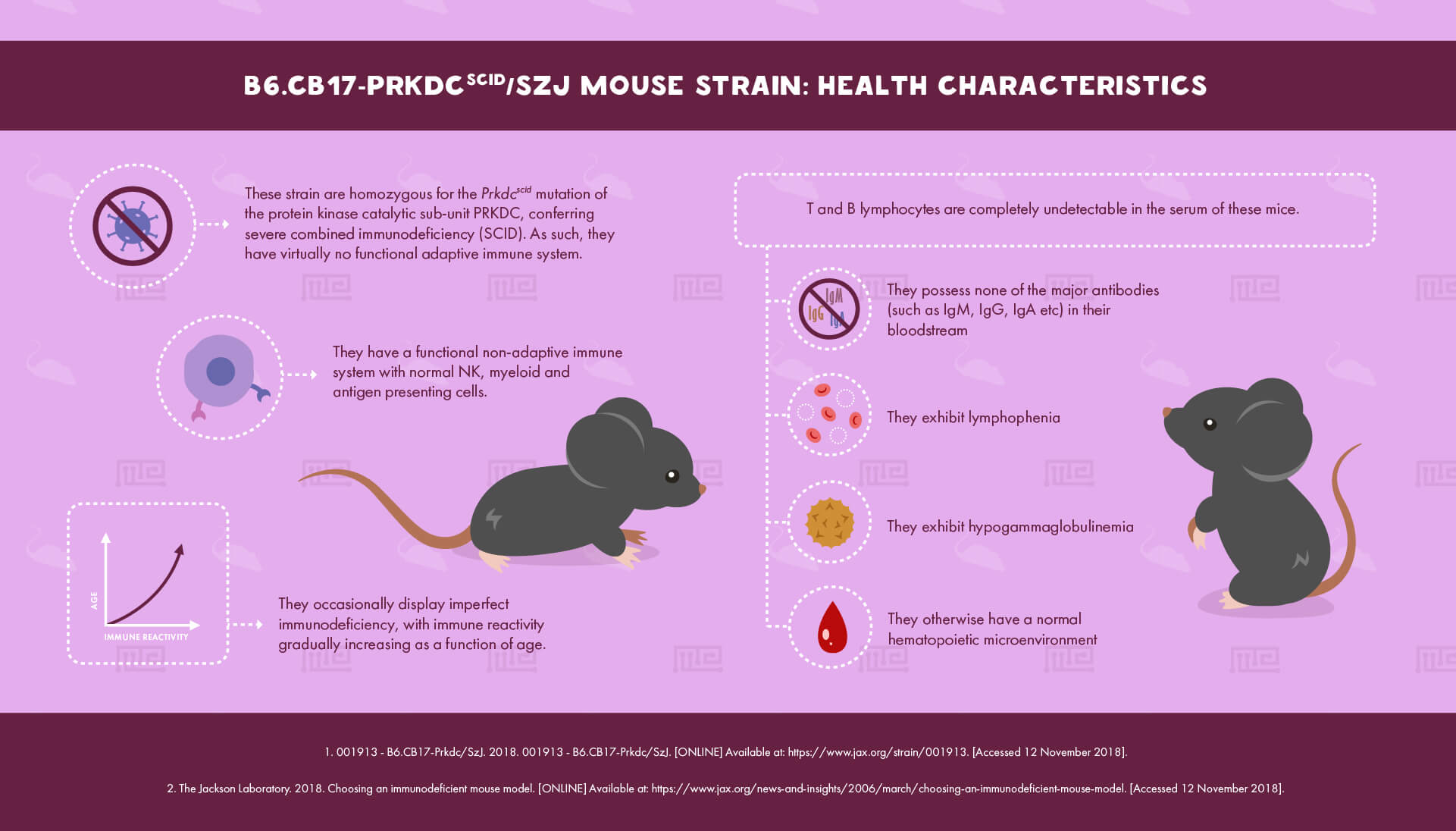Overview
B6.CB17-Prkdcscid/SzJ, also known as B6 SCID or C57BL/6J SCID, is a variant of the popular C57BL/6J strain that exhibits severe combined immunodeficiency (SCID).[1]
History
B6.CB17-Prkdcscid/SzJ is derived from C57BL/6J, which was originally developed by Little in 1921. A spontaneous mutation conferring SCID was observed in a stock of BALB/c mice at the Institute for Cancer Research in Philadelphia. The mutation was transferred to B6 mice during ten generations of backcrossing, after which inbreeding was used to render it homozygous.[2]
Physical Characteristics
Mice of the B6.CB17-Prkdcscid/SzJ strain have black fur and are very similar in appearance to the regular C57BL/6J strain.[1]
Behavioral Characteristics & Handling
Like all immune-deficient mice, individuals of the B6.CB17-Prkdcscid/SzJ strain must be handled with great care at all times. They must be kept in a sterile environment free from all pathogens, and handled as infrequently as possible, always wearing gloves when doing so.
These mice show a greater preference for social interaction than normal C57BL/6J mice. This is likely related to the fact that they do not display normal dishabituation in a social recognition test, suggesting they have social memory deficits. This aberrant social interaction was associated with inadequate maternal care.[3]
Health Characteristics
B6.CB17-Prkdcscid/SzJ mice are homozygous for the Prkdcscid mutation of the protein kinase catalytic sub-unit PRKDC, conferring severe combined immunodeficiency (SCID). As such, like other SCID strains, they have virtually no functional adaptive immune system.
T and B lymphocytes are completely undetectable in the serum of these mice. They exhibit lymphophenia (greatly decreased lymphocyte concentration) and hypogammaglobulemia (abnormally low levels of the antibody protein gamma globulin). None of the major antibodies (such as IgM, IgG, IgA etc) are present in their bloodstream. They otherwise have a normal hematopoietic microenvironment.
Their non-adaptive immune system is functional, with normal NK, myeloid and antigen presenting cells. Occasionally these mice can be “leaky” i.e. display imperfect immunodeficiency, with immune reactivity gradually increasing as a function of age. Leakiness is generally higher with immune deficient B6 strains such as this one than with NOD SCID or C3H/HeJ SCID mice.[1-4]
Major Experimental Uses
As a SCID mouse, B6.CB17-Prkdcscid/SzJ is mostly used in the study of immunology and immune disorders. These mice can be applied to research into AIDS, SCID, autoimmunity and lymphatic disorders.[1]
As a PRKDC mutant, B6.CB17-Prkdcscid/SzJ is a very good model for severe immunodeficiency; its immune dysfunction is much more complete and less leaky than mice with the Fox1nu allele. Downsides of this model include greater leakiness in older individuals, greater leakiness compared to some other Prkdcscid strains, and the presence of a fully functioning non-adaptive immune system.[4]
SCID strains such as this one are especially suitable for xenografting, as they do not have a sufficient immune response to reject foreign tissue implants. This allows them to be useful for cancer and cell transfer research.[1]
References
- 001913 – B6.CB17-Prkdc/SzJ. 2018. 001913 – B6.CB17-Prkdc/SzJ. [ONLINE] Available at: https://www.jax.org/strain/001913. [Accessed 12 November 2018].
- MGI – Inbred Strains: C57BL. 2018. MGI – Inbred Strains: C57BL. [ONLINE] Available at: http://www.informatics.jax.org/inbred_strains/mouse/docs/C57BL.shtml. [Accessed 12 November 2018].
- Quinnies KM, Cox KH, Rissman EF. Immune deficiency influences juvenile social behavior and maternal behavior. Behav Neurosci. 2015. 129(3):331-8.
- The Jackson Laboratory. 2018. Choosing an immunodeficient mouse model. [ONLINE] Available at: https://www.jax.org/news-and-insights/2006/march/choosing-an-immunodeficient-mouse-model. [Accessed 12 November 2018].


